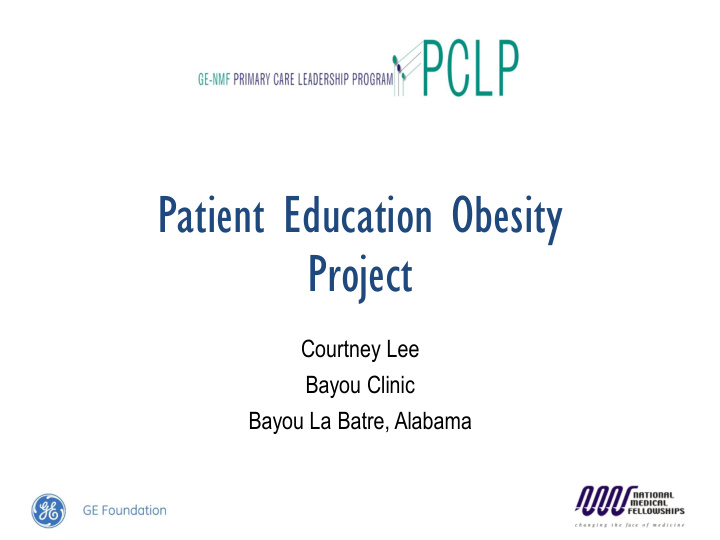



Patient Education Obesity Project Courtney Lee Bayou Clinic Bayou La Batre, Alabama
Introduction • Overview • Background Methods • Results • • Discussion Recommendations • • Personal interest in primary care preventative medicine, obesity Obesity: • Obesity Excess weight, defined as BMI of 30 or more • Contributes to 112,000 Preventable deaths per year. • Obesity-related medical treatment costs between $147 and $210 billion a year (2006 data). • Compared to an average patient: obesity cost an extra $1429- $2741 per year • "Today's epidemic of overweight and obesity threatens the historic progress we have made in increasing America's quality and years of healthy life.” -Dr. Regina Benjamin
Background • Alabama 5th most obese state • According to F as in Fat “How Obesity Threatens America’s Future” • 2010-32.2%, 2012 the prevalence of self reported obesity was 33%. • 2012 : Diabetes 12.3%- 3 rd among states • 2011 Hypertension 40%- 1 st among states • If obesity rates continue to rise by 2030 :13 states-adult obesity rates above 60 percent, 39 states- rates above 50 percent, and all 50 states- rates above 44 percent.
Methodology • Patient Survey: • Patients with a BMI of 30 and above were given an obesity survey. • Option: Obesity Education and/or Action Plan(weight loss program) “Lets Get Started: Making Better Choices” • Educational materials on obesity and weight loss tips were given to patients. • Weight Loss Program “ Lets Get Started Making Better Choices”: • Three Plans: Exercise More, Food Switch, Drink Switch • Success: Doing your plan • Patients in weight loss program were given a pre and post obesity surveys to monitor progress. • Weekly follow-up calls were made to monitor progress • Weight checks were done after two weeks of being in the weight loss program.*
Survey Results • How motivated are you to lose 100% (31/31) of patients were weight? receptive to Obesity Education. Not ready 6.4% • 71%(22/31) considered themselves (2/31) Unsure 32.3% overweight . 10/31 • Ready 61.3% 3% (1/31)considered themselves obese. 19/31 • 29% of patients (9/31) do not have How successful do you think you money at the end of the month for would be at losing weight? food. Not • 62%( 18/31) of patients think eating successful 6% (2/31) healthy costs a lot of money. A little • Successful Patients want to learn more about how 39% (12/31) to lose weight, cook healthy meals and Good exercises to help lose weight. Success 39% (12/31) • Most patients buy groceries from Very successful Greers Food Tiger, Family Dollar and 16% 5/31 Dollar General.
Results Obesity Education 100% 31/31 Action Plan Enrollment 77% 24/31 Successful Follow up Calls 67% 16/24 Unable to make Contact 12.5% 3/24 Dropped from Program 21% 5/24 % Follow up Calls Continuing Plan 81% 13/16 % Weight Check 69% 11/16 % Decrease in Weight 36% 4/11
Discussion • Obesity Education issues : • Perception: Patients don’t identify as obese and they believe eating healthy cost a lot of money • Patients misperception of healthy drinks and the normal number of meal intake per day. • Questions Raised/ Barriers • Patients lack motivation on follow- up calls or hadn’t started yet. • Follow-up to Clinic was low due to lack of transportation, unable to contact, other medical issues • Patient Finances • Time- 4 week project • Future Research Projects • Focus on modest weight loss of 5-10 percent of weight. Ex: 200 lb. patient loosing 10 pounds. • Encourage Healthy Lifestyle: target overweight patients BMI 25 and above • Should focus on one part of patient perception ex: obesity, BMI and Body Image. • Access Motivation Techniques- outside the office • Long-term: weight loss should be monitored monthly and reassessed to adjust goals/treatment.
Recommendations • Obesity education continued with emphasis on : • Harmful effects of obesity • Sugary drinks • Portion control • Understanding calories and healthy weight loss . • Set goal for weight loss at 5% of patients weight. Encourage Healthy Lifestyles: patients overweight: BMI 25 and up • Assess where patients are on change readiness ruler and make adjustments accordingly. • Patients who are ready need a written action plan, multiple options for weight loss, information to help stop cravings, and follow-up calls/visits .
Conclusion • Obesity education is important to decrease incidence of preventable diseases and mortality. • Health and financial benefits if obese patients loose 5% of their weight • Change Readiness Ruler is a tool that could help providers gauge patients motivation for weight loss. • “Every time you eat or drink you either feed disease or fight it” – Heather Morgan We will fight together!
Acknowledgements • GE-NMF PCLP General Electric National Medical Fellowship Program • The Welcoming Patients and Staff of Bayou Clinic: • Dr. Regina Benjamin • Ms. Erin Canady-P.A. • Ms. Tiffany More Awesome • Dr. Lopez • Mrs. Julie Taylor-Site Supervisor • Mr.Isiah Lineberry • Ms.: Charlotte, Tina , Pat, Maria, Pam, Cyndi • Dr. Motley- Faculty Advisor • Lauren Auer
Recommend
More recommend